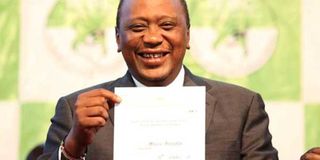Uhuru needs reset button to survive political turbulence

President Uhuru Kenyatta holds his certificate after he was announced winner of the repeat presidential election at Bomas of Kenya in Nairobi on October 30, 2017. PHOTO | RAPHAEL NJOROGE | NATION MEDIA GROUP
What you need to know:
With the handshake done and dusted – even if its resultant technocratic processes are still ongoing – what other reset buttons does the President have in seeking to put off all fires, especially the new ones which have started within government post-handshake?
This will remain a headache for President Kenyatta — whether he has to make peace with his deputy’s camp or take politically punitive measures against them.
One way or another, the President has to pull an Obama on the mini-Russias happening within his government, by first providing a reset button.
In March 2009 in Geneva, Switzerland, the then US Secretary of State Hillary Clinton presented Russia’s long-serving Foreign Minister Sergei Lavrov with a symbolic reset button. It was a tiny circular red knob with the word “reset” written on it. The button was mounted atop a little yellow cube.
ANTAGONISTIC
The idea was for the two top diplomats representing the perpetually antagonistic states to jointly hold the cube in their hands, before pressing the button together, ushering in a new era in the relations between Russia and America. This was President Barack Obama’s way of extending an olive branch to his Russian counterpart, Dimitry Medvedev, with whom he imagined they could enjoy a less abrasive interaction.
Much as the reset didn’t last as long as desired, there were initial gestures of goodwill, with both countries making important policy concessions beneficial to each other’s geo-political interests. Russia, for example, opened its airspace for the US to transport supplies into Afghanistan, and America relaxed sanctions against the Russians.
With all its shortcomings, the allegorical significance of the act by Mrs Clinton and Mr Lavrov was that it was a show of possibility, that no matter how longstanding the differences between two states are, there is always hope that diplomacy and similar little gestures of goodwill go a long way in unlocking complicated impasses.
Today, President Uhuru Kenyatta finds himself in the unflattering position where were he to play Mr Obama’s role in such a reset, the Head of State has to face little Russias within his Jubilee administration — all of which are making the country feel that the President is either too lenient, clueless, or lacks the courage to act.
Of course the latest series of mini-Russias within government emanate from key lieutenants of the Deputy President, starting with Leader of Majority in the Senate Kipchumba Murkomen. Speaking during the burial of one of his aides who was killed, the Elgeyo Marakwet Senator threw salvos at the President, alleging that had a different regime been in power, his aide wouldn’t have died in the manner which he did.
ASSASSINATIONS
‘‘My message to President Uhuru Kenyatta is that security will not be managed in this country through assassinations and extrajudicial killings,’’ an angry Mr Murkomen said. ‘‘This is not the way to run this nation.’’
In the preceding week, Mr Murkomen tweeted protestations on the arrest of Dennis Itumbi, the Director for Digital in the Presidency, made a guest of the state in the course of investigations into the origins of a letter relating to an alleged “assassination” plot against the Deputy President.
Following Mr Murkomen’s footsteps closely was Kapseret MP Oscar Sudi, who while pushing for the release of Mr Itumbi, alleged that there was a cabal within government plotting against those perceived to be supporting the Deputy President’s 2022 presidential bid, pointing fingers at a certain rogue “chairman” purportedly being assisted by former senior presidential advisor Nancy Gitau.
‘‘No matter how many people they arrest or jail,’’ Mr Sudi said, ‘‘No matter how many people they plot against, no one can stop us. This is exactly what they did to Miguna Miguna. In fact we will fight to bring Miguna back. I know they’ve said some will be assassinated. But we are not squatters in Kenya. We will fight back.’’
Some may consider these utterances as sideshows which require naught attention least of all from someone of President Kenyatta’s official and political stature. But seeing that these are members of his party who are closely associated with the President’s Number Two, it surely cannot continue being business as usual.
POST-HANDSHAKE
More importantly, the Deputy President himself has not self-censored, despite the President’s endless pleas for the political noise to be tamed. Speaking in Kisii recently, Dr Ruto referred to ODM leader and African Union envoy Raila Odinga as the lord of poverty, in one of his high-pitched no-holds-barred speeches.
In recent history, the one thing that resembles the Russia-America reset has to be the March 2018 handshake between President Kenyatta and Mr Odinga, which quelled some fires, and seems to have lit a set of others.
This, therefore, begs the question: with the handshake done and dusted – even if its resultant technocratic processes are still ongoing – what other reset buttons does the President have in seeking to put off all fires, especially the new ones which have started within government post-handshake?
This will remain a headache for President Kenyatta — whether he has to make peace with his deputy’s camp or take politically punitive measures against them. One way or another, the President has to pull an Obama on the mini-Russias happening within his government, by first providing a reset button.
Granted, this will only be a starting point, since once he attains functional alignment within government, then he can start resetting his other countless governance challenges.





